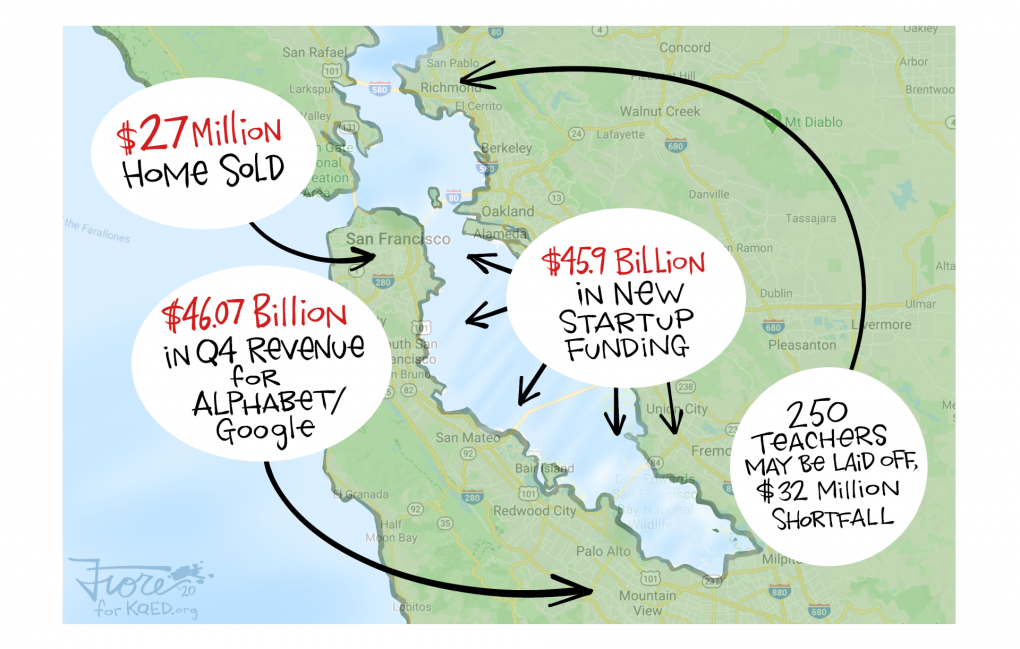Are Universities Facing A Financial Meltdown? Pay Cuts, Layoffs, And The Future Of Higher Education

Table of Contents
Declining Enrollment and its Impact on University Finances
Shrinking Student Population
Decreased birth rates in many countries, coupled with shifting demographics and evolving student preferences, are contributing to a shrinking student population. This translates directly into less tuition revenue, a cornerstone of most universities' financial models.
- Decreased birth rates: Lower birth rates in several developed nations mean fewer potential college applicants in the coming years.
- Changing student demographics: The demographics of the student body are shifting, with a growing proportion of non-traditional students and a changing demand for specific degree programs.
- Competition from alternative education models: Online learning platforms and vocational training programs offer cost-effective and flexible alternatives, attracting students away from traditional universities.
Fewer students enrolling directly impacts a university's bottom line. Tuition revenue, which often accounts for a significant portion of a university's budget, is directly correlated to enrollment numbers. A decline in enrollment, therefore, creates a domino effect on the university's financial health.
Increased Competition Among Universities
The higher education landscape is fiercely competitive. Universities are vying for a shrinking pool of students, leading to price wars, escalating scholarship offers, and intense marketing battles.
- Price wars: Universities are often forced to lower tuition fees to remain competitive, thereby reducing their revenue.
- Scholarships and financial aid packages: The pressure to attract students necessitates increased investment in financial aid, further impacting the university's budget.
- Marketing and recruitment strategies: Universities are investing heavily in marketing and recruitment to attract students, adding to their operational costs.
This intense competition forces universities to operate on increasingly tighter margins, making them more vulnerable to even minor financial setbacks. The race to the bottom on tuition prices can be detrimental to the overall financial health of institutions.
Rising Operational Costs and Budgetary Constraints
Inflation and Increased Expenses
Universities, like all organizations, are facing the pressure of inflation. The cost of everything from utilities and salaries to technology and research is steadily rising.
- Increased energy costs: Utilities, including electricity and heating, represent a significant expense for large campuses.
- Rising salaries for administrative staff: Maintaining a competitive compensation structure for administrative staff is crucial but adds to the overall cost.
- Investments in technology infrastructure: Universities must invest in updated technology to stay competitive, which can be a substantial financial undertaking.
These inflationary pressures often outpace the growth in tuition revenue, resulting in budget deficits that universities struggle to manage.
Underfunding from Government and Private Sources
Many universities rely on government funding and private donations to supplement tuition revenue. However, both sources are becoming increasingly unreliable.
- Decreased government grants: Many governments are reducing their funding for higher education due to budgetary constraints.
- Competition for private endowments: Universities face intense competition for limited private donations, making it challenging to secure substantial funding.
- Reliance on tuition revenue: This over-reliance makes universities extremely vulnerable to fluctuations in student enrollment.
Reduced funding from these sources exacerbates the financial pressures already faced by declining enrollment and rising operational costs. This lack of external support forces universities to rely even more heavily on tuition revenue, making them even more vulnerable.
The Consequences: Pay Cuts, Layoffs, and Program Cuts
Faculty and Staff Layoffs
Budget cuts often lead to painful decisions regarding university personnel. Layoffs among faculty and staff are becoming increasingly common.
- Faculty reductions: Departments may be forced to reduce the number of faculty members, impacting teaching capacity and research output.
- Staff cuts in administrative and support roles: Reductions in administrative and support staff lead to increased workloads for remaining employees.
- Increased workload for remaining employees: This can negatively impact morale, productivity, and the quality of services provided.
These layoffs not only cause significant hardship for individuals but also erode the institutional knowledge and expertise that are essential to a university's success.
Salary Reductions and Frozen Wages
In addition to layoffs, universities are often forced to implement salary reductions or freeze wages.
- Reduced purchasing power: Salary reductions decrease employees' purchasing power, impacting their morale and potentially leading to higher turnover.
- Difficulty attracting and retaining talent: Lower salaries make it challenging to attract and retain highly qualified faculty and staff.
- Potential for decreased employee morale: Salary freezes or cuts can significantly impact morale and productivity.
These measures further contribute to a decline in the quality of education and research at universities.
Program Cuts and Course Eliminations
To address financial shortfalls, universities may resort to eliminating academic programs or courses.
- Reduced course selection for students: This limits student choices and potentially reduces the overall quality of education.
- Elimination of less popular programs: This can result in a narrower range of academic specializations offered by the university.
- Potential impact on research and specialization: Program cuts can harm a university's research capabilities and its reputation in specific fields.
The reduction in academic offerings directly impacts the university's ability to offer a diverse and comprehensive educational experience to its students.
The Future of Higher Education: Potential Solutions and Adaptations
Exploring New Revenue Streams
Universities must actively seek new revenue streams to supplement traditional funding sources.
- Online education: Expanding online offerings can reach a wider student base and generate additional revenue.
- Corporate partnerships: Collaborating with corporations can provide funding and create opportunities for practical, industry-relevant education.
- Increased fundraising efforts: Strengthened fundraising campaigns can help secure private donations and endowments.
- International student recruitment: Attracting international students can bring in substantial tuition revenue.
Diversifying revenue sources is crucial for long-term financial stability.
Rethinking the Traditional Model
The traditional university model may need significant reforms to address current financial challenges.
- Increased efficiency: Streamlining administrative processes and reducing operational costs can free up resources.
- Strategic partnerships: Collaborating with other institutions can share resources and reduce duplication of efforts.
- Technology integration: Leveraging technology can improve efficiency and enhance the learning experience.
- Alternative pedagogical approaches: Innovative teaching methods can improve learning outcomes while potentially reducing costs.
Adapting to the changing landscape requires innovation, flexibility, and a willingness to embrace new approaches to education.
Conclusion
Many universities are indeed facing a significant financial crisis, characterized by declining enrollment, rising costs, budget cuts, and the subsequent consequences of pay cuts, layoffs, and program cuts. This crisis threatens the quality of higher education and the future of these institutions. The financial future of higher education depends on proactive solutions. Let's discuss how we can address this potential university financial meltdown and ensure the long-term viability of our institutions. We must explore new revenue streams, rethink the traditional model, and work collaboratively to find sustainable solutions for a brighter future for higher education.

Featured Posts
-
 The Blake Lively Controversy How Selena Gomezs Insight Impacts Taylor Swift
May 18, 2025
The Blake Lively Controversy How Selena Gomezs Insight Impacts Taylor Swift
May 18, 2025 -
 Todays Mlb Home Run Props Expert Predictions And Odds May 8th
May 18, 2025
Todays Mlb Home Run Props Expert Predictions And Odds May 8th
May 18, 2025 -
 Asamh Bn Ladn Awr Alka Yagnk Ayk Hyran Kn Telq
May 18, 2025
Asamh Bn Ladn Awr Alka Yagnk Ayk Hyran Kn Telq
May 18, 2025 -
 Russia Hands Down 13 Year Prison Term To Australian Ukraine Fighter
May 18, 2025
Russia Hands Down 13 Year Prison Term To Australian Ukraine Fighter
May 18, 2025 -
 Taylor Swifts Eras Tour An In Depth Look At Her Stage Wardrobe
May 18, 2025
Taylor Swifts Eras Tour An In Depth Look At Her Stage Wardrobe
May 18, 2025
Latest Posts
-
 Southwest Washingtons Economic Outlook Navigating The Tariff Challenge
May 18, 2025
Southwest Washingtons Economic Outlook Navigating The Tariff Challenge
May 18, 2025 -
 Southwest Washington Preparing For The Impact Of Tariffs
May 18, 2025
Southwest Washington Preparing For The Impact Of Tariffs
May 18, 2025 -
 Economic Development Commission Secures 800 K For Florida Space Coast
May 18, 2025
Economic Development Commission Secures 800 K For Florida Space Coast
May 18, 2025 -
 Florida Space Coast Edc Receives Major Funding Boost 800 K Grant
May 18, 2025
Florida Space Coast Edc Receives Major Funding Boost 800 K Grant
May 18, 2025 -
 800 000 Grant Awarded To Florida Space Coast Economic Development Commission
May 18, 2025
800 000 Grant Awarded To Florida Space Coast Economic Development Commission
May 18, 2025
